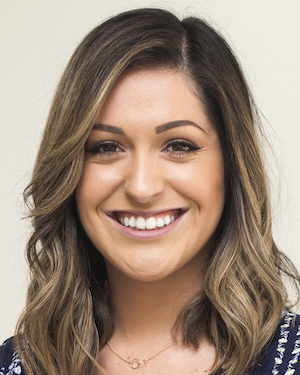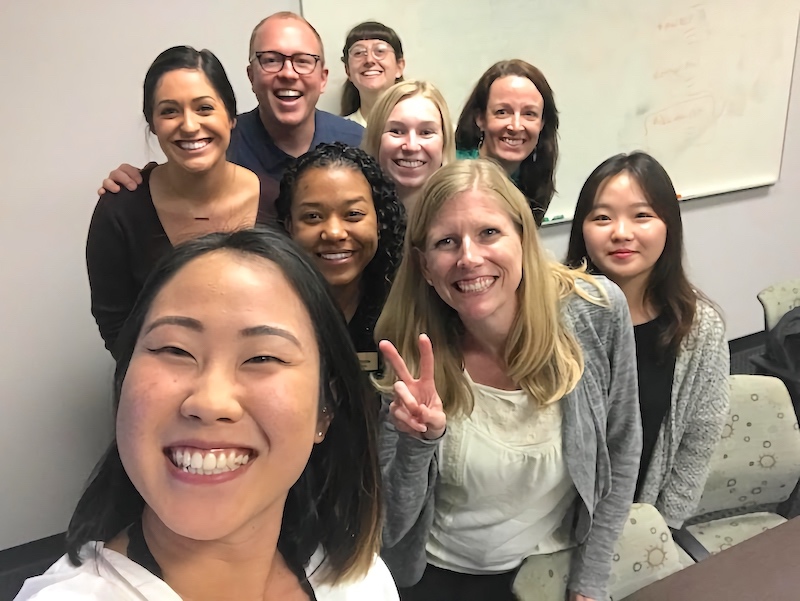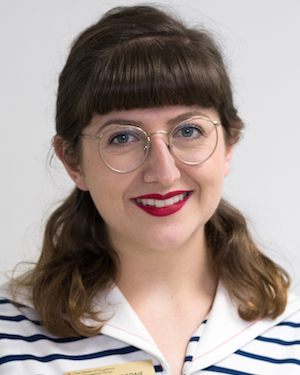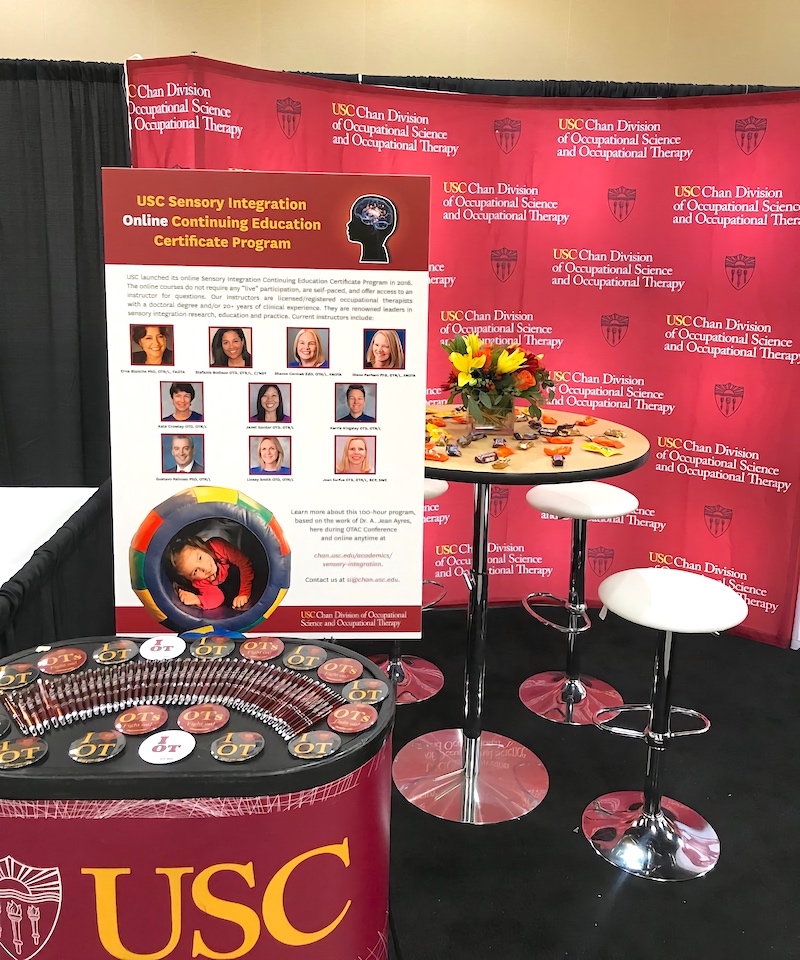Student Blog
Getting Involved

OTSC ⟩
November 30, 2018, by Evan
Getting Involved
I’ve spoken in a few posts about my role as OTAC representative for the student body at various external events, but have yet to touch my role the executive board of OTSC. OTSC stands for Occupational Therapy and Science Council, and is a student organization that has a significant influence on the extracurricular lives of students in the Chan Division. ALL students are stakeholders in the OTSC organization and welcome to attend monthly meetings. The Executive Board of OTSC includes elected representatives from other student organizations, plus a variety of other elected leadership positions. We are also blessed with the guidance of two wonderful faculty liaisons. OTSC meetings generally serve to facilitate communication between the various student organizations, as well as provide a forum in which information can be disseminated and various events can be coordinated. For instance, last April the other OTAC chair and I wanted to host a letter writing party to promote advocacy on state legislative issues. By announcing our intentions at an OTSC meeting we were able to get the word out to the whole student body, vastly increasing participation, and even got a budget approved so that pizza could be provided! I’d encourage anyone pursuing a degree in the Chan Division to find a way to get involved in OTSC. Not only is it a great way to be of service, some of my closest friends in the program have come from this type of extracurricular participation. Feel free to message me if you have any questions!

⋯

What is it like to be a Student Ambassador? ⟩
November 4, 2018, by Melissa
Getting Involved
Hey guys! For this post I wanted to talk a bit about what I do as a Student Ambassador. I feel like we do a bit of everything, therefore I wanted to offer some more insight in case any of you would like to pursue this position when you’re in the program!
First, I want to provide a bit of background information on my journey to becoming a Student Ambassador. When I was first considering applying to USC, I attended an information session and had my first interaction with an Ambassador. I remember thinking, “Wow, that’s such a cool opportunity for students!” but didn’t think much about it after that as I was more concerned with getting into the program at the time. As the application date got closer, I scheduled a meeting with Dr. Carley — the previous Director of Admissions — and a tour with a Student Ambassador. It was an incredibly personal experience; Dr. Carley answered some of my burning questions about the application, and the ambassador shared about her experience with the program and answered my questions regarding life as a student. It was then that I realized how badly I wanted to get into the OT program at USC, and how much I would love to be a Student Ambassador.
Fast-forward two years, and here I am! It’s still pretty surreal to think back to that time, and I’m incredibly grateful to be able to be a part of this program and to be an Ambassador. This position gives me the opportunity to combine my passion for the program and my passion for occupational therapy all into one!
So what exactly do we do? Well, I wasn’t kidding when I said that we do a little bit of everything. We help with information sessions, we correspond with potential applicants and admitted students, we give presentations to pre-health and pre-OT clubs to spread the word about our program and OT as a whole, we present and table at conferences and grad fairs, we give tours to students and their families, and help with all sorts of events! Although there are things that we all do as Ambassadors, there are also things that are unique to each of our positions! For example, Joyce is in charge of all things social media, Serena and I help the admissions team and have Diversity projects that we work on, Jess is responsible for event planning, and Evan works on the content calendar! We each get to work on things that appeal to us and that we have a skill set in, which makes the job even more interesting. In addition, we have an Ambassador from the OTD program as well as the MA-I (post professional) program, which makes us a pretty well rounded team. They each correspond with students that have questions about their specific programs, and have their own individual projects as well.
Ultimately, this job provides us with a great opportunity to advocate for our profession, to increase awareness about OT and the Chan program, and to give potential applicants information about our program from a student’s point of view, among many other things. I’m very lucky to be a part of a team that is made up of such kind, hard-working, and passionate people that make the job so much fun.
If you have any questions about the position or about scheduling a tour with us, feel free to reach out!

⋯

Presenting at Conference ⟩
November 2, 2018, by Antonietta
Classes Getting Involved
The past few weeks have been so exciting (and exhausting). I presented at two conferences; the first was AOTA’s Education Summit, in Louisville, KY, and the second, closer to home, was the OTAC’s annual conference in Pasadena. It was an amazing experience and I wanted to share a little bit about it!
In the second year of the Master’s program, I elected to do Directed Research (OT590) with Dr. Rafeedie, completing 2 units in the Fall and 2 units in the Spring. As I’ve mentioned before, I’m interested in education so I created this experience to do some research about pedagogy and best practices when it comes to simulation. My inspiration for this topic stemmed from being frustrated in some of my courses when asked to role play with my peers. I was quite uncomfortable role playing and I was not convinced it added my clinical skills as a future occupational therapist. From this seed of frustration grew the foundation of our presentations: a low to high fidelity chart for the different types of simulations, an evidence matrix outlining the support for simulation in education, recommendations from the literature about best practice surrounding this instructional method, and finally a piece that I was not expecting at all when I started out. This unexpected piece was the most interesting of them all . . . looking at simulation from the disability perspective.
Upon reflection, this perspective is the root of why I was uncomfortable with simulation in class. Although the goal was to learn, it felt a little bit like a mockery when I pretended to have a prescribed difference. It took looking at this in class requirement from an outside, academic point of view, and discussing it with my mentor to be able to identify the source of this discomfort and start to think critically yet constructively about it. We went to the disability literature and discovered that since the 1990s it has contained a call to stop disability simulation. It cites research which has shown that disability simulation has many unintended consequences. So, we looked further, read more research, and started to build an idea of what types of simulation add to positive educational outcomes and how we can use simulation respectfully and ethically. The bottom line is, we need to be coupling simulation with lived experiences perspectives. As OTs, we valued the phenomenological components of care and recovery that simulation does not provide. These nuances, which simulation simply cannot capture, are what sets us apart from other healthcare professionals. We must be mindful about explicitly including the disability perspective in our curriculum and learning activities.
It was exhilarating to share what we found and developed at the two conferences. Our audiences were very active participants with many questions and different points of view to share. This has been an amazing way to end this project (for now) and it was only possible because of Dr. Rafeedie and USC, so Fight On!

⋯

2018 OTAC Annual Conference ⟩
October 29, 2018, by Serena
Getting Involved
This past weekend the Student Ambassador team and I set up USC’s booth for the Occupational Therapy Association of California (OTAC) Annual Conference in Pasadena. I wanted to share a few pictures of the booth that attracted so many occupational therapists and occupational therapy students interested in the many programs that we have to offer. In particular, there was much interest in the Doctorate of Occupational Therapy (OTD) program, Doctor of Philosophy in Occupational Science (PhD) program, and Lifestyle Redesign®. However, there was an overwhelming interest in our USC stickers and Halloween candy!
Poster board of the many USC Trojans receiving OTAC awards and presenting at the OTAC conference with the beautifully displayed USC Chan Division pens.
⋯

Student Run Clinic’s 8th Annual Interdisciplinary Health Symposium ⟩
October 29, 2018, by Serena
Getting Involved
At USC Student Run Clinic‘s (SRC) 8th Annual Interdisciplinary Health Symposium, students from Medicine, Physician Assistant (PA), Pharmacy, and Occupational Therapy (of course!) programs explored healthcare topics related to homelessness in Los Angeles.
There were many honorable guest speakers doing fantastic work in their respective fields. One was a Physician Assistant and USC alumni, Brett Feldman. However, his documentary Close to Home: Street Medicine was nominated for an Emmy so he was unable to make it.
Another honorable speaker discussed her experiences receiving healthcare as a woman living on Skid Row. She shared her wisdom and advised us to
- meet the patient where they are at or else we will experience burnout.
- put the person first and not the chart, start off by asking, “How are you today?”
- make sure our services come from the heart.
She was asked, “What is the most difficult thing about being homeless?” She replied back that the cold, wind, and finding a restroom were the most challenging aspects about being homeless. Her next comment struck me, which was that “No one teaches you how to be homeless.”
As an OT student I was intrigued by this statement. OTs acknowledge how lifestyle changes when one becomes homeless. We focus on developing ways to address challenges that come with new daily activities such as changes in sleep and toileting routines. It was a huge eye opener that the area that she listed to be her number one challenge was a specific area that OTs address.
Dr. Stephanie Moon, who is an occupational therapist at the Student Run Clinic advocated so passionately and eloquently about the many ways that OTs can help promote health in the homeless population. She proudly stated how OTs are the “Masters of Function”, how our secret sauce is activity analysis (looking at how difficult a task may be for a person), and the importance of addressing occupational deprivation (the loss of ability to participate in activities that are meaningful). Dr. Stephanie Moon stayed true to the creativity that OTs bring to the healthcare system by sharing a story on how she compiled recycled cardboard to create an elevated surface that would allow a patient who was homeless to experience better sleep quality.
Attending the 8th Annual Interdisciplinary Health Symposium was a wonderful experience. I loved gaining different perspectives and learning about more ways to better advocate for the field of OT.
Occupational therapy students representing the profession at the Student Run Clinic’s 8th Annual Interdisciplinary Health Symposium
⋯











